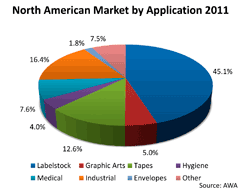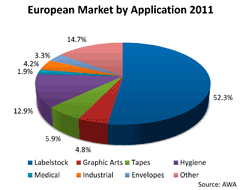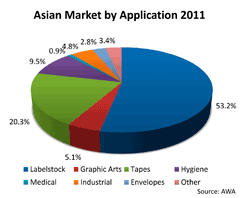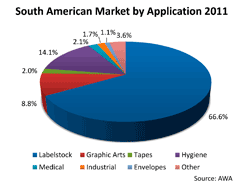Release Liner | Industry Conference Covers Market Data & Trends
- Published: April 12, 2012
The Global Release Liner Industry Conference and Exhibition, organized by AWA Conferences and Events, is annually the meeting point for participants in this specialist industry, at all levels of the value chain. Siliconized release liner’s major market is in pressure-sensitive labeling, but it supports and protects materials in a surprisingly diverse range of applications, from building and construction to electronics, photovoltaics, medical disposables, and pressure-sensitive vehicle wraps. The conference alternates between Europe and the USA, and this year was held in Amsterdam’s Hotel Novotel Amsterdam City.
The exhibition proved to be an excellent focus for the whole event, which has networking at its heart, and featured leading suppliers across the value chain.
Keynote presentations
Opening the formal conference proceedings on the first day, Corey M. Reardon, president and CEO of AWA Alexander Watson Assoc., introduced an afternoon of keynote presentations that addressed the industry status quo in the context of the global economy.
Carsten Lange, managing director, Release Liner, Coatings and Consumer Packaging, for Mondi, discussed the macro-economic outlook for the release liner industry. In the longer term, he observed, it will be countries to the east of Europe and in Latin America that will evidence the greatest growth. In the current financial climate, Austria, Belgium, and Germany are faring best in Europe—but consumer confidence is declining, and in this “second recession,” neither governments nor banks are in as good shape as they were in 2008. The Eurozone, he observed, may represent only 25% of the global economy—but China exports 25% of its GDP to Europe.
In terms of release liner itself, there is, he said, very little official data available in an industry that is dominated by private companies or large groups where release liner data are not reported in detail; and, equally, there is very little comparative data on raw materials. “On the silicone side,” he said, “our industry represents only a minor part of the whole.”
With European manufacturing capacity in the merchant release liner business increasing between 2010 and 2013 by 15%-16% (not all of it aimed at the European market), Lange observed, “We have to understand and manage capacity very carefully.” Currently, Mondi’s estimated CAGR in Europe is 2%-3%, depending on segment. To maintain a healthy future for the business, he said, companies need to invest; to set aside a sufficient percentage of turnover for capital expenditure; and be ready to make allowances for expansion and other developments.
The global economy
John Graham, partner in Amsterdam-based Graham, Smith & Partners, international tax counsel, in a refreshingly clear and direct examination of the different financial markets around the world, discussed the subject in three ways—namely via the traditional, philosophical, and media-influenced approaches. He highlighted the stagnant Japanese market; the US, which, he said, has not dealt with any of its financial issues yet (and will not do so before the elections); the BRIC countries—which still have their own problems; and, of course, Europe and the euro—hailed in 2008 by the EU commissioner for economic and monetary affairs as a “major success” and a “pool of stability for the global economy.”
Release liner industry survey
Reardon returned to the rostrum to present the brand new findings of the 2012 AWA release liner industry survey, peopled with around 100 responses from industry participants around the world. Sentiment has changed in the past year: more companies consider themselves to be regional rather than global, though most expect to see true globalization within five years, and most, he said, believe that “being global provides opportunities for growth.” Mergers and acquisitions within the value chain also will continue. Costs have increased dramatically—even over prior year, which itself experienced tremendous cost pressures. “Looking forward,” he said, “costs are still expected to rise, but at a slightly lower rate.” Inventory pressures remained an issue in 2011, as they had in 2010.
The day’s proceedings concluded with time at the exhibition and a cocktail reception.
Market data
 Next day’s full program began with a market overview of the global release liner market from Corey Reardon, who shared AWA Alexander Watson Assoc.’s current research data. In terms of materials and markets, glassine/calendered kraft papers still represent a solid 41% of the overall market, with film currently taking 12% (see Figure 1). Pressure-sensitive label stock remains the largest segment, at 51%.
Next day’s full program began with a market overview of the global release liner market from Corey Reardon, who shared AWA Alexander Watson Assoc.’s current research data. In terms of materials and markets, glassine/calendered kraft papers still represent a solid 41% of the overall market, with film currently taking 12% (see Figure 1). Pressure-sensitive label stock remains the largest segment, at 51%.
Reardon predicted that “in this market, 40 percent to 60 percent of liner usage for primary product labeling will migrate to film in the next five years.” He added that variable information print (itself representing 50% of the label market for release liner) will, however, always remain paper-based.
North American market by application
 Geographically, North America retains the largest share of the 35,254 mln sq m global market for release liner, though Europe and Asia Pacific are nearly equal. In all three geographic markets, label stock applications have the lion’s share of the market.
Geographically, North America retains the largest share of the 35,254 mln sq m global market for release liner, though Europe and Asia Pacific are nearly equal. In all three geographic markets, label stock applications have the lion’s share of the market.
In North America, label stock holds 45.1% of the market (see Figure 2).
Industrial applications are second at 16.4%, and tapes are 12.6%.
European market by application
 For the European market, the percentage for label stock is higher at 52.3% (see Figure 3).
For the European market, the percentage for label stock is higher at 52.3% (see Figure 3).
Hygiene applications hold 12.9% of the market, just behind Other applications. The next highest for the European market, at 5.9%, are tape applications.
Asian market by application
In Asia, the percentage for label stock is even higher than Europe or North America, at 53.2% (see Figure 4).
 Tapes are solidly in second place with 20.3% of the Asian market.
Tapes are solidly in second place with 20.3% of the Asian market.
SOUTH AMERICAN MARKET BY APPLICATION
For the South American market, label stock is far and away the leading application for release liner with 66.6% of the market (see Figure 5).
Hygiene applications come in second at 14.1%.
 North America is more optimistic about its growth opportunities in 2012—predicting 5%+ growth, as does Asia Pacific—than South America, which anticipates 2%-5% growth, and Europe, which expects 0%-2% growth. Overall, growth has slowed, but Asia Pacific remains the growth leader and will, said Reardon, “take over as the main region in the near future.”
North America is more optimistic about its growth opportunities in 2012—predicting 5%+ growth, as does Asia Pacific—than South America, which anticipates 2%-5% growth, and Europe, which expects 0%-2% growth. Overall, growth has slowed, but Asia Pacific remains the growth leader and will, said Reardon, “take over as the main region in the near future.”
Packaging and labeling law
Changing packaging and labeling laws are today a major concern in the broad packaging industry, and therefore for pressure-sensitive labels. Solicitor and law lecturer Charles James has just published the second edition of his "Guide to Packaging and Labelling Law," and introduced delegates to some of the “headlines” that are current.
BPA and food contact concerns around film liners; migration issues; new food labeling regulations—where origin labeling of meats is a particular challenge are all issues—but legislation like the Plastics Directive are delivering real opportunities for packaging companies to innovate and demonstrate their proven skills and integrity.
Tailor-made products for labels
Dr. Peter Sandkuehler, group leader, TS&D, Performance Plastics, for Dow Chemical Co., went on to discuss the many aspects of developing tailor-made products for the label industry in which Dow Chemical Co. is involved—including hot melt and acrylic adhesive formulations and films for facestock and release liner.
Trends and drivers today include, of course, sustainability and health and safety legislation, which must partner maintaining and developing the aesthetics of labels for enhanced branding. These are areas where Dow’s global presence and broad science and technology capabilities can contribute at all levels of the label value chain.
Composites—and yacht building
Packaging is not the only arena in which release liners have a part to play. The AWA release liner survey highlighted the fact that the second-largest market segment, at just over 12% of the total, is specialty tapes. Prefaced by an introduction to the pre-impregnated composites market and its value chain from Corey Reardon, professional yacht builder Steffen Hak gave a practical demonstration of the different ways in which release liners are used in the luxury yachting industry. They feature both in pressure-sensitive tape and sealant applications and in non-adhesive “pre-preg” substrate protection for such items as the rails around the ship and flagpoles and hatches.
Heineken’s perspective
The beer market has been one of the success stories for pressure-sensitive labels in recent years, and delegates were able to share Heineken’s perspective on the release liner industry, as presented by the company’s Global Category Buyer for Packaging Materials, Dennis Bakx. “The consumer is changing his consumption pattern: people spend money in a different way today,” said Bakx. The beer market is no exception. Demand is moving away from dispensed drinks in bars to home consumption, both using bottles and cans—and this has had a positive effect on Heineken’s use of pressure-sensitive labels.
Heineken choose pressure-sensitive labels because, Bakx said, they support the company’s international brand (“communicate by packaging”) by adding value for both the retailer and consumer, and also deliver a practical advantage—high packaging line speeds. But Heineken also has a “wish list,” and delegates were challenged to contribute to further improving release liners on pressure-sensitive label stock. He asked, “What will be the next generation?” Reduced liner thickness/downgauging and linerless labels are possible future options, and innovation and sustainability are, of course, key factors. He said, “About 40% of the pressure-sensitive product we buy is waste! My job is to reduce or optimize!”
Recycling initiatives
Release liner recycling initiatives from the label industry were the subject of the presentation from Mark Macaré, public affairs manager of the European pressure-sensitive label association, FINAT. Outlining the political and corporate drivers of action in this arena, he went on to detail the use of secondary materials in the label chain, recycling bottlenecks, and FINAT’s role in supporting and promoting industry initiatives.
Macaré said that “70 percent of brand owners identify sustainability as a competitive advantage,” and green initiatives by both brand owners and retailers are having a significant impact on overall awareness of the key sustainability issues. In the past year, FINAT has established a recycling project group and is actively promoting and raising the awareness of the importance of recycling for the label industry, as well as positively demonstrating the suitability of siliconized paper liner for paper recycling.
FINAT is a signatory to the European Declaration on Paper Recovery. The association’s sustainability action agenda is wide-ranging. Macaré indicated that release liner—the highest priority—and pressure-sensitive label matrix and set-up waste are key areas where the association is concerned to identify and promote secondary materials/recycling solutions. He said that establishing an active industry network and developing and maintaining a database/catalog, as well as setting up effective communications across the value chain and the media (including success stories) are also prime objectives. FINAT awaits the finalization of the latest revision to the EU Packaging and Packaging Waste Directive, to learn whether label release liner will be defined as process waste or packaging waste.
Silicone and release coating panel discussion
Following lunch, a session addressing silicone and release coating technologies opened with a panel discussion involving three industry experts: Christian Velasquez, global market director, Pressure-sensitive Industry, for Dow Corning; Mikko Meyder, global marketing manager, RC Silicones, for Evonik Goldschmidt; and Sean Duffy, global business manager, Bluestar Silicones.
The discussion, moderated by Corey Reardon, was wide-ranging. Panelists agreed with Meyder that “thinner, lighter, more stable substrates for release liner” are needed, but that, as Velasquez remarked, “We have to be able to sell ourselves on the total value of the self-adhesive label, not just the release liner.” On the topic of film liner, Duffy observed that “in cost terms, the option of choosing a film liner versus a paper liner now makes economic sense.”
Substrate-identical label constructions—a PP liner on a PP facestock, he said, offer huge advantages in terms of recyclability. The limited success of non-traditional substrates such as PLA films; the future role of solvent siliconization; increasing in-line siliconization by pressure-sensitive laminators, as well as siliconization/lamination at the converter stage; and the high cost of raw materials were among other topics addressed.
Automatic inspection and measurement
Innovative optical inspection and measurement systems for in-line quality and process control for film release liner production were the topic of the paper presented by Dr. Schenk GmbH Industriemesstechnik’s senior business development manager, Hans Oerley. The advantages of automatic inspection over human inspectors, he showed, are considerable.
Defects and irregularities are often invisible to the human eye, especially at high web speeds; human inspection cannot continue consistently for 24-hr periods; and automatic inspection can not only deliver process optimization through fast feedback of data, but also provide archival information on defects. The company’s EasyInspect and EasyMeasure systems offer flexible, leading-edge solutions for release liner production, at all stages of the process.
Linerless labels?
Disruptive technologies and innovations that are impacting release liner were the topic of the final conference session. The renewed challenge of linerless pressure-sensitive labels was explored by Jackie Marolda, VP and senior consultant, AWA Alexander Watson Assoc. The drivers for a move to linerless labels are the desire to reduce/eliminate waste; legislation; the cost of release liner; and the economics of liner waste. The AWA release liner survey 2012, she showed, identified interesting current sentiment. Involvement in recycling/reuse programs has hardly grown at all. “We’re all talking about it,” Marolda said, “‘but it’s all very future orientated.”
Conversely, survey respondents identified linerless labels as an area where they expect to see innovation—and market substitution—in the near term. Linerless labels today have their limitations—label shape (though clear film labels can bear a printed shape), material supply, application machinery (here, Europe is ahead of North America), and application speeds. But they have clearly already “found a niche” in today’s market. Marolda said that, additionally, there are developments in facestocks, activatable adhesives, and printable silicone coatings. There are also developments in application equipment—hybrid machines capable of applying both traditional and linerless pressure-sensitive labels—and in converting equipment, allowing for radius-cornered labels and shaped perforations.
Direct-to-product print
Digital inkjet printing, direct to the product, is now a reality—and potentially a major disrupter for the traditional label industry. Clayton Sampson, managing director of Cyan Tec, demonstrated how his company’s inkjet printers, laser systems, and robot automation can deliver single-pass printing for a variety of markets, which currently include aerospace, automotive, consumer products, electronics, food packaging, medical devices, and textiles. The technology offers short run and variable data capabilities, prints on uneven surfaces and complex shapes, and requires no make-ready time. It has far-reaching strategic implications for traceability and anti-counterfeiting, particularly in pharmaceutical packaging, and for mass customization of consumer products.
Innovative drying system
Another challenge to traditional, established thinking in the release liner industry was posited by Gene Plavnik, president, Heat Technologies Inc. His company’s US-patented, proven Spectra HE ultra drying system employs advanced convective heat and mass transfer technology—drying, curing, cooling, and heating—enhanced by strong acoustic oscillations. In projects involving coating, converting, and other in-line processes, Plavnik showed, a 50-in. long drying unit using Spectra HE technology can replace a traditional 56-ft long dryer and will use only 13% of the energy consumed by its predecessor. Heat Technologies Inc. offers complete design and manufacturing for a variety of projects, large and small.
A brief supplier innovation forum featuring Billerud, Dow Corning, Dow Chemical, Dr Schenk, and Loparex, rounded off the conference agenda prior to cocktails around the exhibition area.
The Global Release Liner Conference & Exhibition 2012 was truly representative of the industry it served in terms of sponsorship, featuring platinum sponsors UPM; gold sponsors Billerud, Blue Star Silicones, Dow Corning, Evonik, Loparex, Mondi, and Toray; and silver sponsors Boise, CVG Paper, Dow Chemical, Dr. Schenk, Felix Schoeller, and Mitsubishi Polyester Film; as well as many of the world’s leading converting media.
AWA Conferences & Events will hold the annual Label Release Liner Seminar at the Hyatt Rosemont, Chicago, USA, just prior to this year’s Labelexpo, on Sept. 10, 2012.












